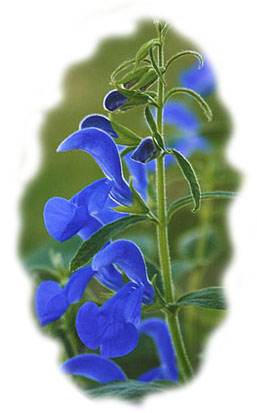
The Gardens - Annuals, Perennials and Edibles
Welcome to my Colorado garden near the base of the Rocky Mountains!
Here, in unincorporated Jefferson County, Colorado, I have a little over
an acre to experiment with. The plants in this mile high country have to put up with
temperatures that very often swing 30 to 40 degrees Fahrenheit during
a 24 hour period and spring gusts called chinooks that can reach over 100 mph.
The 100 mph gusts aren't as bad as they sound, since the air is thinner here
than at sea level.
As of 1998, I grow over
400 roses and have several water gardens.
This page is about the other plants I grow - annuals, perennials and things to
eat.
Bugs in the Garden - some of our carnivorous visitors and nectar lovers
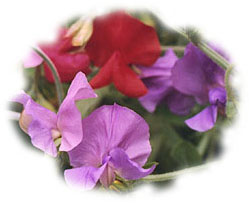 Annuals
Annuals
- African Daisy variety 'Zulu Prince' * - Venidium fastuosum var. alba
- Sunscape Daisy variety 'Sonja' -Osteospermum
- Canary Bird Vine
- Cardinal Climber
- Cleome
- Cosmos - Cosmos bipinnatus and Cosmos sulphureus varieties 'Ladybird' and 'Sunset' - Cosmos bipinnatus blooms constantly
from early summer until frost in colors ranging from white to pink to a dark purplish red.
It now even comes in a pale yellow, although I find the pale yellow variety to be
substantially stingier in its blooms. Cosmos bipinnatus is great at reseeding itself -
so much so that it has become quite a weed. Most of it gets pulled out or there wouldn't
be anything else.
- Mexican Sunflower - Tithonia * -
Tithonia flowers glow from across the yard with their bright orange/red
blooms. They are one of my best plants for attracting butterflies to the
yard.
- Morning Glory - Ipomoea tricolor variety 'Heavenly Blue' - I started them inside
This spring (1998) which was a mistake. They do much better if sewn directly in the
garden. Still, they are a gorgeous true blue.
- Pinwheel Marigold: * - This marigold has single flowers with high contrasting
yellow/maroon stripes. It's been reseeding itself for years in my gardens.
- Plains Coreopsis (Calliopsis) - Coreopsis tinctoria - This is a very bright and cheery flower
that starts blooming in early summer and keeps going until frost. The flowers come
in clusters of bright yellow and deep maroon, and the foliage is rather light and
airy. Calliopsis is zeric in Colorado, and I've seen it used in wildflower mixes
along the entrance ramps of highways here. It prefers full sun.
It is easy to grow from seed by
planting directly or by planting early inside. I'll find out next year if it
reseeds.
- Pineapple Sage - Salvia elegans
- This sage is tender in USDA zones colder than 8, but can get to a pretty good
size before the fall freeze. It blooms very late in the fall and most years the frost
catches it before it blooms. Here is the entire plant in late October, 1998.
- Salvia - Lady in Red - This short form
of Salvia coccinea blooms non-stop all summer with bright red flowers. The
local hummingbirds found these flowers very attractive.
Here is one of the plants near my upper pond.
- Salvia - Indigo Spires -
- Salvia guaranitica -
- Salvia leucantha -
- Gentian Sage - Salvia patens
This salvia is said to be perennial in USDA zone 8, but it is grown an
an annual here. It started flowering early in the summer and I was able
to keep it going somewhat all summer by deadheading the spent bracts.
The flower is the most gorgeous true blue I have ever seen.
- For more salvias - see perennials list
- Sun Flowers:
variety - Red Sun
and another Red Sun Sunflower
bird seed seedling - These grow
under my bird feeder for obvious reasons. :-) They do not have the dark
centers the varieties do, and are still quite pretty.
variety - Discovery Mix. Self seeded this year and
virtually all are polyheaded. Quite a variety of color and flower form.
* Behind many of these sunflowers you see the deep blue Colorado sky.
A Floridian friend calls this color 'alien blue' because it seems to
dark that it looks unreal.
Some of my favorite images of these Sunflowers:
- Flowering Tobacco - Nicotiana alata *
- Sweet Peas
- Zinnias - varity Righteous Red.
Zinnias are another great butterfly attractant.
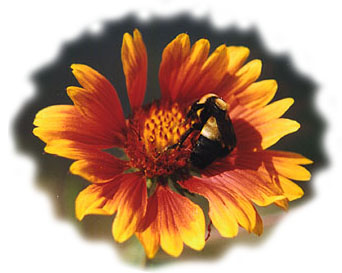 Perennials
Perennials
- Alliums - Moly (yellow), Giganteum,
Azureum (blue), Bulgaricum, Senescens 'Glaucum' and Ostrowskianum
(pink)
- Artemesia - variety 'Silver King'
- Scarlet Bee Balm - Monarda didyma variety 'Gardenview Scarlet'
- Blanket Flower - Gaillardia aristata: varieties Gaillardia x grandiflora
'Burgundy' and
Gaillardia 'Kobold'
- Carnation - variety Grenadine
- Coral Bells - Heuchera sanguinea
- Creeping Babies Breath
- Coreopsis - varieties Early Sunrise and
Moonbeam
- Crocus
- Daffodils
- Dahlias - variety Procyon and
Alfred Grille
- here in Colorado, dalia tubers must be lifted in the fall and stored in
a cool dry place.
- Day Lilies - variety Stella de Oro
- Delphiniums
- Dianthus - various varieties including deltoides variety 'Artic Fire', Dianthus
gratianopolitanus variety 'Spotty' and Dianthus
allwoodii. Most of my dianthus are very hardy and bloom profusely in the spring.
Deadheading usually results in another flush of blooms and some keep coming
all summer long. They are easy to propagated by just cutting off some of
the plant and sticking it in a pot. I haven't needed to put the cuttings in
a more humid environment, even here in dry Colorado. My neighbor ripped
out some of hers which I then rooted and
planted in my garden.
- Feverfew - Chrysanthemum parthenium
- Foxglove
- Grape Hyacinths - Muscari armeniacum - this is the most commonly
planted variety,
and Muscari
latifolium which has two different kinds of flowers on each stalk.
The top ones are smaller and a light bluish purple in color, and the lower
ones are a maroon purple color. The foliage has a much broader leaf as well.
- Hyacinths
- Iris, German and reticulata
- Lilies - Oriental variety 'Stargazer'
- Liatris - variety 'Kobold'
- Lavender - variety 'Munstead'
- Lupines
- Prairie Coneflower - Ratibida columnaris
- Poppies - Iceland Poppy, Oriental Poppy,
Alpine Poppy
- Rudbeckia - hirtia variety 'Rustic Dwarfs' and others, and fulgida variety 'Goldsturm'
- Salvia azurea 'Grandiflora' -
This salvia is supposed to be hardy here in Colorado, so we'll see how it
handles the winter of 1998/1999. It started blooming in early September
and kept going until a good hard freeze in October. The plant is rather
floppy, so it's propped between some cosmos and other plants. The blooms
are sky blue.
- Salvia transylvanica
- St. John's Wort
- Sea thrift - Armeria maritima - can
produce quite a sea of pink
- Tulips - untold varieties
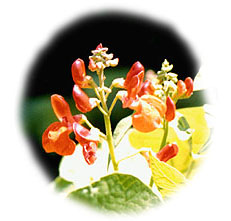 For the table
For the table
- Apples - various unknown varities that came with the house.
- Asparagus - I don't know what
variety we have, but it produces very large, tender stalks
- Basil - Licorice
- Beets - Detroit Dark Red
- Beans - Scarlet Runner - These are very ornamental and would work in a
flower garden
- Carrots
- Cherries - variety 'North Star'
- Chives - traditional, garlic and society
- Corn - Candy Corn, Ilini Extra
Sweet and Rainbow Inca
- Garlic
- Grapes - variety 'Himrod Golden Seedless'
- Gourds - various hard shelled varieties
- Licorice Mint (Anise Hyssop) Agastache foeniculum *
- Plums - Green Gage and Stanley Prune Plum
- Peas - Sugar Snap
- Peppers - Anaheim
- Pumpkins - Autumn Gold
- Rhubarb - variety Chipman's Canada Red
- Tomatoes - varieties Better Boy, Brandywine, Roma and Sweet 100
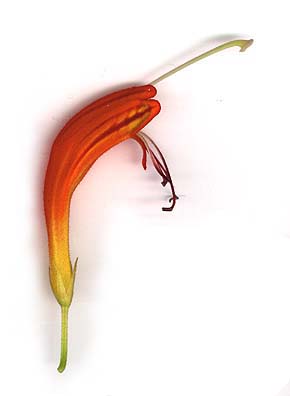 House Plants - The Indoor Garden
House Plants - The Indoor Garden
* found at Seeds of Change
Send all comments to
Cheryl Netter
Back to The Netter Page
Table of contents for the entire site
©1998 C.NETTER





